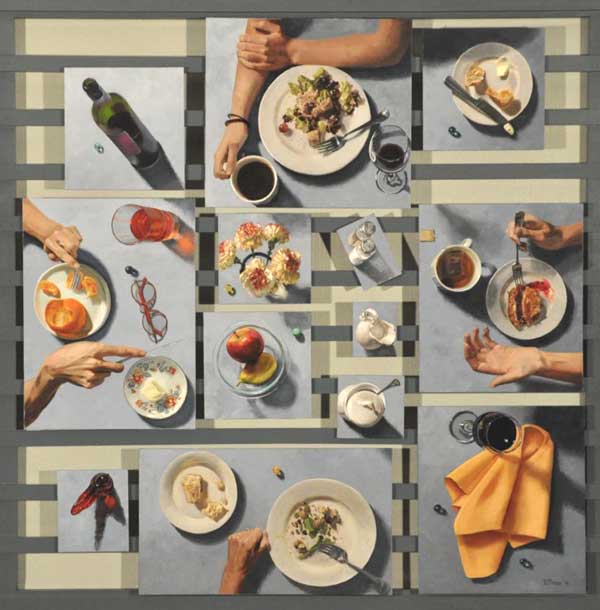Reuben Kirkham: Pioneer Artist
 Credit: Donna Poulton© Available at: Amazon.comReuben Kirkham was a pioneer artist—part of a first generation of Utah artists whose brush strokes provide an enduring documentation of life on the fringes of civilization. Arriving in Salt Lake by mule train in 1868, Kirkham took his place among a handful of archaic and self-taught artists. The young man would devote the last eighteen years of his life to learning his craft and producing volumes of sketches and scenes for numerous theatre and opera productions, panels for his panoramas and easel works. His works express the romantic idealization of nature common in landscape paintings of the mid-nineteenth century, but also bear the stamp of his unique style and the challenging environment and vistas of the west.
Credit: Donna Poulton© Available at: Amazon.comReuben Kirkham was a pioneer artist—part of a first generation of Utah artists whose brush strokes provide an enduring documentation of life on the fringes of civilization. Arriving in Salt Lake by mule train in 1868, Kirkham took his place among a handful of archaic and self-taught artists. The young man would devote the last eighteen years of his life to learning his craft and producing volumes of sketches and scenes for numerous theatre and opera productions, panels for his panoramas and easel works. His works express the romantic idealization of nature common in landscape paintings of the mid-nineteenth century, but also bear the stamp of his unique style and the challenging environment and vistas of the west.
 Credit: Donna Poulton© Available at: Amazon.comUntil now it was thought that only a few of his works had survived, but through diligent research and detective work, historian Donna L. Poulton has uncovered many sketches and oil paintings that further attest to Kirkham’s remarkable body of work. Many of those will be made public for the first time in this book. Several important paintings, found in lamentable condition, have now been restored and preserved by the Springville Museum of Art as a result of her important research. Furthermore, Poulton discovered another facet of Kirkham’s work: that of photographer, mastering a relatively new medium and using his natural sense of framing, composition, texture and contrast to document life in the untamed west.
Credit: Donna Poulton© Available at: Amazon.comUntil now it was thought that only a few of his works had survived, but through diligent research and detective work, historian Donna L. Poulton has uncovered many sketches and oil paintings that further attest to Kirkham’s remarkable body of work. Many of those will be made public for the first time in this book. Several important paintings, found in lamentable condition, have now been restored and preserved by the Springville Museum of Art as a result of her important research. Furthermore, Poulton discovered another facet of Kirkham’s work: that of photographer, mastering a relatively new medium and using his natural sense of framing, composition, texture and contrast to document life in the untamed west.
 Credit: Donna Poulton© Available at: Amazon.comIn all, this engrossing work provides a moving and often awe-inspiring portrait of a man who overcame considerable odds to develop and exploit his God-given talents. It sheds new light as well on the artist’s remarkable, multiple abilities, while describing in often heartbreaking detail the life and times of a man who truly did suffer for his art. A complete painting raisonné accompanies this book.
Credit: Donna Poulton© Available at: Amazon.comIn all, this engrossing work provides a moving and often awe-inspiring portrait of a man who overcame considerable odds to develop and exploit his God-given talents. It sheds new light as well on the artist’s remarkable, multiple abilities, while describing in often heartbreaking detail the life and times of a man who truly did suffer for his art. A complete painting raisonné accompanies this book.
 Credit: Donna Poulton© Available at: Amazon.com
Credit: Donna Poulton© Available at: Amazon.com Credit: Donna Poulton© Available at: Amazon.com
Credit: Donna Poulton© Available at: Amazon.com
 Tuesday, July 24, 2012 at 10:16PM Tweet
Tuesday, July 24, 2012 at 10:16PM Tweet  “The Conversation,” by Barbara Pence. Credit: Barbarapence.com
“The Conversation,” by Barbara Pence. Credit: Barbarapence.com Barbara Pence,
Barbara Pence,  Painting,
Painting,  Portraiture,
Portraiture,  Springville Museum of Art,
Springville Museum of Art,  Still Life,
Still Life,  conversation,
conversation,  meals | in
meals | in  Barbara Pence
Barbara Pence 









